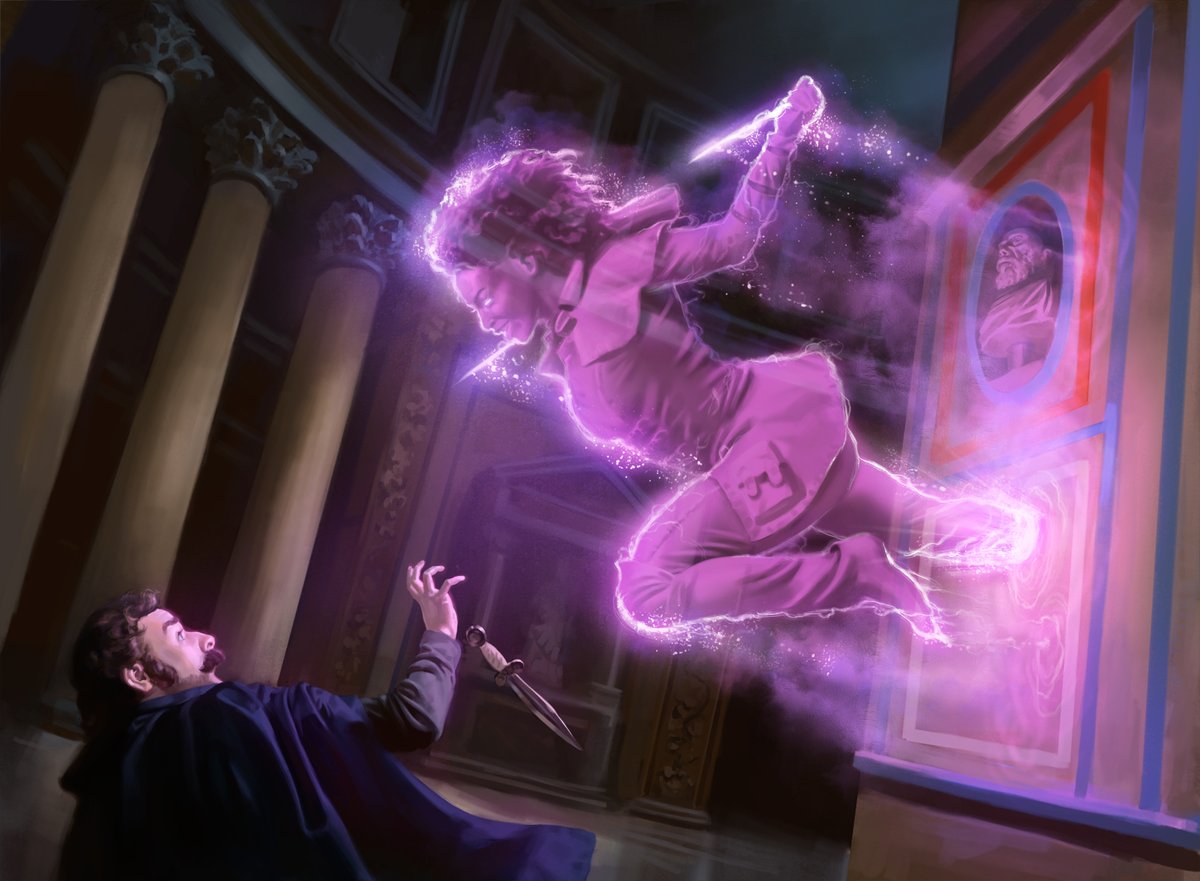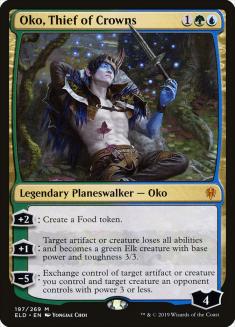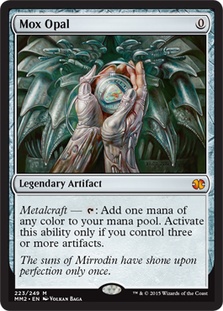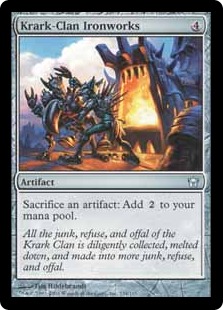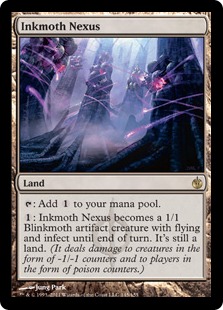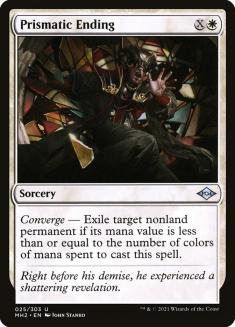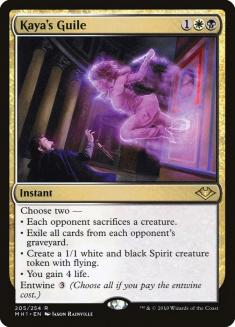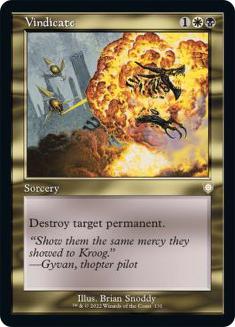Throughout my career, most of my cheerleading has been for Standard. However, in competitive Magic, Modern is my absolute favorite format to play. Rotation is traditionally an important part of keeping the game healthy and vibrant, something that Modern does not do. That general truth has broken down in recent years, with us watching the Standard trainwreck continue without reprieve. I still enjoy playing Standard and will continue to do so, but my heart is with Modern for the foreseeable future.
Modern has undergone many bannings throughout the years. There’s always something that the masses want out, usually artifact-related or some nonsense from a recently released Standard set. Those demands have hit an all-time low and I’m one of the picketers who has lowered his sign. I often voice my opinion through my work here on which cards should be removed from or returned to Modern. There are still a few cards on the Banned List that I believe should come off; however, it will not make or break the format at this point. Modern is good — really good — and I think (for the first time) that nothing needs to change to improve it.
We recently saw the second live major Modern event of the year roll through the United States at CFB Las Vegas. That event had more players, but a much smaller purse and open invitation. Normally that would make it difficult to compare the results to those of the SCG Invitational at SCG CON last month, but the competitors included some of the all-time greats. With fierce competition and a thirst for paper Magic, this event provides valuable data when analyzing the Modern metagame. For years, we have just had Magic Online success as our metric and now we have two very competitive events to gauge the health of the Modern format. To my surprise, the results of this Top 8 were completely different from those of SCG CON.
Although the SCG Invitational was a mixed-format event, there were eight grueling rounds of Modern that involved only qualified players. I joined another Azorius wizard at the top of the format leaderboards, finishing 8-0 at the end of swiss. My good pal, Corey Baumeister, was upset with this stat line on Twitter, as he finished 7-0-1 in the format, with an intentional draw at the end. Unfortunately for him, his only solace at the end was winning the entire event. I hope he will accept the results of the final format records and find comfort with his giant trophy!
The top performers of the SCG Invitational in Modern did not match those of CFB Las Vegas. The CFB event had multiple copies of Amulet Titan, a Four-Color Control (Kaheera), wild Rakdos Midrange (Lurrus) and Four-Color Indomitable Creativity decks, random appearances of Sultai Infect and Hardened Scales (Lurrus), and one Jund Midrange (Lurrus) deck.
The last deck on this list I expected, and I was not surprised by a Four-Color Control (Kaheera) deck sneaking in. The other members of that Top 8 paint a very diverse picture of the competitive scene in Modern, one that brings a smile to this jaded, old control mage.
I often criticized Modern to be a format of aggro, just many different flavors of it, that put on the illusion of deck diversity. That format is gone, with the widest array of aggro, midrange, control, big mana, and combo all being viable, with no best deck in sight. Although I was saddened by the absence of Azorius Control, I know how powerful the deck is in the current metagame. Most of the decks in this Top 8 I would be very comfortable battling against, but I think it may be time for a small change to address the randomness that this format can bring.
Azorius Control is good at defeating the mainstream decks but would have a difficult time against some of the enemies of old. A deck like Sultai Infect would massacre a control deck that commanded an arsenal of only sorcery-speed removal outside of Solitude itself. The expansion of decks that utilize the graveyard is likely to increase, as the associated cards of those strategies are highly efficient. Lurrus of the Dream-Den is simply too good not to rule Modern and I only see decks using it increasing in number.
Azorius Control has access to Rest in Peace; however, I’m not convinced the deck can successfully maneuver around other decks if that is a possible dud drawn in Game 1. For maindeck graveyard hate that’s acceptable, instant-speed removal, and keeping the core strength of Azorius Control intact, look no further than Esper Control to save the day.
After going 8-0 at the SCG Invitational with Azorius Control, it would be difficult for me to put it down completely. I have switched to wacky combo decks when control is at a low point in Modern, but that isn’t the case here. Control is great and the spells continue to get better with each Modern-specific set printed. Play Design sees that control’s viability is a key to format health and without it, the creature-based decks ruin everything. It becomes a race to the bottom, whichever is the fastest and most all-in, to then be able to defeat the combo/big mana decks out there. With competitive control in the mix, the metagame reaches equilibrium, and you see a format like the current Modern.
This Esper Control deck is a spitting image of Azorius Control, using the most important aspects and expanding on the areas of weakness that demand addressing after the recent results. Paper Modern looks a bit like Magic Online now, with the deck diversity at a maximum. Prismatic Ending may be the best control spell that we’ve seen in a decade, but it cannot handle the workload on its own in the current metagame. The focal point for the switch to Esper Control is upgraded removal, cards that I have logged many hours casting throughout the years.
The best of the best is Kaya’s Guile, a card that was ridiculed by most content creators upon its release. I never lost hope in it, playing copies in each control deck that had the requisite colors needed to cast it. Eventually, the card broke through in Esper Control and the Modern metagame had a strange leader for about a month. Even I was shocked by Esper Control being the best deck, but I knew it was because of Kaya’s Guile.
I concede that it has lackluster abilities on paper; however, control players are used to mediocre effects on their cards. Gaining four life is the first thing that sold me because maindeck lifegain is something that control players need to handle any format that has a heavy aggro presence. Modern is diverse, but there are still a ton of decks with multiple one-drop creatures, making lifegain in Game 1 still impactful. Instead of two shocklands, Esper Control has four, which is another reason why four life is a top-notch effect on any spell.
Kaya’s Guile also provides blockers and removal that line up perfectly against some of the decks we saw in the Top 8. Against Sultai Infect, there’s no removal spell as clean as this one, blowing up a creature and avoiding many of the protection spells that they deploy when trying to save it. The removal spell is the best silver bullet against them, but the 1/1 creature with flying also threatens a trade when matched up against their threats. Kaya’s Guile may be a joke card to some; however, no Sultai Infect player is laughing when the opponent casts it.
Infect creatures kill instantly, but there are others that cleverly maneuver around the sorcery-speed removal spells that Azorius Control depends on. Having this instant-speed removal against creature-lands; a Primeval Titan; an Omnath, Locus of Creation; or even an Emrakul, the Promised End is game-changing. Azorius Control has Solitude, though the stress put on that card to do everything is high.
Kaya’s Guile is the only instant-speed removal spell added to the initial Azorius Control shell, but others can be added if needed. There are metagame shifts that could call for Vanishing Verse to join the team, or other black-based removal; it depends on what we see moving forward. At this point, Kaya’s Guile is the key to success, with its removal, lifegain, and blocker. These attributes would be good enough on their own, but there’s another piece to Kaya’s Guile that gives control an edge in Game 1 over the competition.
Graveyard removal is the last mode of Kaya’s Guile. The Top 8 we saw in both events had decks that summon threats and advantage from the graveyard. I mentioned the strength of Lurrus; Kaya’s Guile is the counter to it. Rest in Peace is far superior out of the sideboard, but having that Game 1 answer builds an additional layer of strength for control in the format rankings. Although not as strong as Kaya’s Guile, there’s another black spell in the three-mana slot that brings additional pain to unsuspecting opponents before the sideboarded games.
Vindicate is an answer-all that I have played since I got into the game. It destroys everything at a three-mana premium. The combination of Vindicate, Spreading Seas, and a greedy Field of Ruin gives Esper Control this strange avenue of land destruction to win the game. Attacking the manabase while leaning on Chalice of the Void for spell prevention makes Esper Control one of the cheesy decks we see in the current Modern metagame.
Like those relying on Blood Moon, control players sleep just fine after they cast one spell to defeat their opponent. Modern is better than it’s ever been, even though the power level is at an all-time high. At this point, control players must fight fire with fire, which is what Vindicate (and company) assist in doing.
The last black spell added to the maindeck is Esper Charm. This is one of the cards that has fallen in favor with me some with the strength of Archmage’s Charm. It’s tough to justify another three-mana slot to this card while using Vindicate; Archmage’s Charm; Teferi, Time Raveler; and Kaya’s Guile.
It appears that Esper Control has many more three-mana spells clogging up the pipes, but the numbers are close. There’s one fewer Teferi, Time Raveler and two fewer Archmage’s Charm, making room for the black spells. It’s still valuable to keep Esper Charm in the mix, with opportunities often popping up to remove the last few cards in an opponent’s hand. That, in addition to drawing cards or destroying an enchantment, gives it the flexibility that makes the other spells in Esper Control that good. Azorius Control has a very streamlined, consistent series of disruption it produces, while Esper Control can branch out to handle more difficult situations.
The sideboard is close to my traditional Azorius Control setup. The numbers have shifted to address the new diverse metagame, but the core is relatively close to what I have had recent success with. Aether Gust is a must-increase to handle the Amulet Titan nonsense, while being applicable to the rest of the CFB Las Vegas Top 8. It’s just a great card that doesn’t get the play it deserves in Modern. The fourth Kaya’s Guile replaces any need for aggro assistance, as it does it all in those matchups.
I shifted around the maindeck numbers and still wanted Shark Typhoon for the control mirrors, increasing the count in the sideboard. Outside of the fourth Kaya’s Guile, the only black card in the sideboard is Collective Brutality. This is another way to kill Ragavan, Nimble Pilferer on the play, while being very strong against spell-based decks. Depending on the metagame shifts, more black removal will pour into the sideboard, but not just yet. The format is in a great place now, with all archetypes represented and capable of winning.
I cannot wait until the next live event, where I will cast multiple versions of Teferi and the card Counterspell, counting my lucky blessings that control has busted cards once again.

